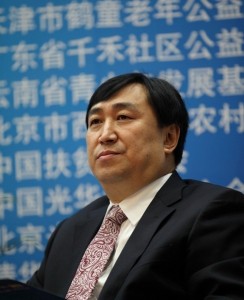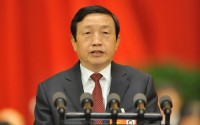Striving For Effectiveness in Chinese Philanthropy
An Interview with Mr.Cheng Gang, President of CFC
 It was cold, foggy and snowy out there on a January afternoon in Beijing. Inside the office of Mr.Cheng Gang, the president of China Foundation Center ( CFC ), I was engrossed in a warm conversation with Mr.Cheng. In front of us was a list of questions I had prepared on Foundation Transparency Index ( FTI ), CFC and Chinese philanthropy. Despite the lingering pain from his dental visit earlier that morning, Mr.Cheng seemed to be very passionate about these topics. Half way through our conversation, I was compelled to push the list aside, looked in his eyes, and asked, “Could you tell me something about yourself? What has got you into philanthropy?”
It was cold, foggy and snowy out there on a January afternoon in Beijing. Inside the office of Mr.Cheng Gang, the president of China Foundation Center ( CFC ), I was engrossed in a warm conversation with Mr.Cheng. In front of us was a list of questions I had prepared on Foundation Transparency Index ( FTI ), CFC and Chinese philanthropy. Despite the lingering pain from his dental visit earlier that morning, Mr.Cheng seemed to be very passionate about these topics. Half way through our conversation, I was compelled to push the list aside, looked in his eyes, and asked, “Could you tell me something about yourself? What has got you into philanthropy?”
There are a lot of outstanding leaders in Chinese nonprofits and philanthropy, but Mr.Cheng seems to be a different type. Talking about FTI, he didn’t speak in glorious terms about the great significance of the unprecedented practice; instead, he was describing the step-by-step process of designing, launching and promoting FTI, and how one obstacle was tackled after another. I didn’t even have to ask for numbers or examples — they just came in handy in his quotes. From his account, he seemed to have a knack of tangoing with different stakeholders, be they foundations, nonprofits, media, or scholars, guiding them toward the direction he has envisioned.
“These are the simplest questions, but very hard to answer.I am an engineer by training.”
To my question, for the first time, he paused, with a thoughtful smile on his face, and said,” These are the simplest questions, but very hard to answer.” then continued, “I am an engineer by training.”
Mr.Cheng worked in the private sector for a long time before joining Youth Foundation in 1993, where he took charge of the national network of information system for the foundation. He grasped the essence of foundation operation during this period. “To build and manage a national information system, you have to have a good understanding on the flow of the whole process.” Between 1998 and 2008, he was a CEO of an enterprise providing technical support and consulting service to large foundations and nonprofits.
When CFC was established in 2010 to build an information platform for foundations, Mr.Cheng’s professional training in technology, expertise in foundation operation, and acumen in business management, made him an ideal leadership candidate. He was selected to be the VP of CFC, then became the president a year later. In the Chinese social sector, most prominent leaders came with an academic background in social science and working experiences in government, so Mr.Cheng’s background is not common. As he unfolded his experiences, a central theme emerged in Mr.Cheng’s leadership — He has always taken a pragmatic approach to achieving effective outcomes.
The positioning of FTI is a good illustration of this central theme. CFC’s mission was set to promote transparency among foundations and to strengthen the philanthropic sector. Sounds good? But the path was not very clear. CFC is just an ordinary nonprofit organization, established under the voluntary support and good faith of 35 Chinese foundations, and has no authoritative power over any foundation. To a large extent, CFC’s survival hinges on the support from foundations, at least for now. At the same time, lacking transparency is a common problem among Chinese foundations. There seems to be a natural tension between CFC’s positioning and its mission – How can CFC expect to obtain support from foundations while pointing out how wrong they are in disclosure? You could find the answer in one of our earlier article FTI, A True Chinese Innovation.
Taking a closer look at FTI, people may think FTI is not as audacious as it sounds. But if we put FTI in a Chinese context, we should at least applaud two outstanding outcomes it has achieved: it has engaged active participation from at least 1/3 of the total foundations; the public now has a place to examine foundations’ annual report. These are a great leap forward from where it started.
“I do keep an eye on results.”
When you visit many nonprofit organizations in China, “hierarchy” probably would be a noticeable impression, shown in organizational structure, communication process, operation, and even office layout. When you visit CFC, you’ll see a different picture. Mr.Cheng has his separate office, but the rest of the staff shared a large work space, including Mr.TaoZe, the VP at CFC. Although he is often the one who opens the door in the office in the early morning, Mr.Cheng didn’t sound like a micro manager. “I travel a lot, and trust the operation to TaoZe and the team. They make a lot of decisions on their own. But I do keep an eye on results.” Later that afternoon, I met briefly with Mr.TaoZe and two young people in his team. They indeed seemed to take a lot of ownership in what they were doing.
Lacking talent has been widely identified as one of the bottlenecks in advancing the development of the Chinese social sector. To help address this issue, quite a few universities have rolled out master’s program concentrating on public management, many of which lean more toward theory and research. Mr.Cheng figured most graduates from these master’s programs would go to academia or government, and wouldn’t end up in the field doing the groundwork. He thought it would be more effective to build a pipeline of talents for foundations, starting from undergraduate programs. He and Mr.Xu YongGuang, grabbed a good opportunity and started the nation’s first undergraduate program with a philanthropy concentration at Beijing Normal University ZhuHuai Campus with the support of Shanghai SongQingLing Foundation in 2012.
Mr.Cheng took an unconventional, yet practical, approach in admitting students. Among others, the most disputable was the two pre-requisites for application: applicants should get no objection from parents; the family financial condition should be above average. His proposals aroused a lot of controversy among colleagues. He explained his rationale — It’s indisputable that salary and compensation in the social sector are still quite low. For students coming from an underprivileged family, very often, they not only need to sustain themselves after college, but also to support their parents and even their extended family. The salary from working in the nonprofit sector won’t allow them to fulfill their own social responsibilities, which may inevitably undermine their long-term commitment to their work. Meanwhile, in current China, parents still have lots of say over children’s decisions. A student’s commitment in the new concentration may not carry him/her too far if parents would object. Mr.Cheng finally convinced his colleagues, now they have 34 students enrolled in the program. I’ve had some interactions with a few students from the program, and obviously the enthusiasm and morale are high. Mr.Cheng’s hope is to see more colleges follow suit.
Mr.Cheng acknowledged that his thinking was heavily influenced by his engineer training. “Every time I am faced with a challenging task, I tend to consider the desired outcome, and figure out where the potential obstacles may be, then make a plan to tackle each obstacle. What I care the most are results and effectiveness.” That said, he didn’t sound like a rigid manager who only knew about numbers. Instead, he was very personable, and laughed a lot during our conversation.
“I have come to the realization that building a healthy culture is vitally important, either for an organization like CFC, or for Chinese philanthropy as a whole.”
Richard Leider, popular writer of business bestseller and speaker in leadership development, once commented, “Often, ( leaders ) are more comfortable with the technical or financial tasks than with the human issues. They say, ‘ I don’t want to get into all that soft stuff. I just want to get results.” Mr.Cheng didn’t used to talk about the “soft” stuff, but people around him have noticed the change since he worked at CFC. He is talking about values and culture whenever and wherever he has a chance. “I have come to the realization that building a healthy culture is vitally important, either for an organization like CFC, or for Chinese philanthropy as a whole. If people don’t change their mindset, but just focus on doing what they do, they won’t be able to go very far.” With a distant smile on his face, he said, ” You probably won’t believe this, although I was an engineer major and have worked in technological field most of my career, I really enjoy reading about history, geography, and sociology. Also, especially in recent years, I seem to have had a better understanding of my own life and my values. The world seems to be opening up in front of me, and I start finding peace in what I do. I can deal better with failures now. ”
Talking about American philanthropy, Mr.Cheng said, ” I should thank American philanthropy. They have taught me the first lessons on values and culture of philanthropy.” He visits the States a couple of times each year, and described his trips to the States, especially those to the west coast, as “energizing and inspiring.” Every time he is there, he would immerse himself in learning, and try to figure out what could be applied in China.
Asked about his plan and vision for CFC, he laughed, ” I don’t really make 5-year plans. I’m more like farmers. Farmers never think more than two years ahead.” Then, he continued, “CFC is entering its third year since inception. We Chinese tend to think 5 years as a milestone. And I do have a vision for CFC in 2015. I hope by then, CFC has achieved a sustainable growth, and been well recognized in the philanthropic field for the value it has delivered. We have moved very fast in the last two years, so this year, among my major goals are to build a stronger team with shared values and to lay a solid foundation for our future growth.”
Besides building a stronger organization, finding a viable business model seems to be another major concern hovering in Mr.Cheng’s mind. Although CFC was modeled after Foundation Center in the United States, they are operating in two worlds of stark differences. Foundation Center has been operating successfully on a networked economy, with strong support and engagement from both sides of the platform, namely the foundation world and nonprofits. Neither side is strong in China now. Mr.Cheng doesn’t have an answer yet, but I have confidence in him, not just because of the track record he has established with his leadership in CFC, but also because he is focusing on “value creation”, which is the center of all business models.
“Feel for the stone while crossing the river.”
I also truly wish Mr.Cheng and CFC success. During my recent trip to China, I’ve been fortunate to talk to a wide range of amazing people. What I have learned kept bringing me back to my study on Chinese economic sector before the opening reform. Despite the distinct differences between the social sector now and the economic sector then in wealth level, societal background and openness to the outside world, they share one thing in common: the spirit and practice of exploring. Just think about the secret land privatization experiment started in a village, and the first few rural and township enterprises. These experiments existed far before a clear government policy came in place. Managing market economy was a new task for the Communist Party 30 years ago, so the Party followed the strategy set by Deng Xiao Ping, ” Feel for the stone while crossing the river.” The government would hesitate to make a policy change until “stones”, successful practices and experiments, were clearly felt.
The Chinese social sector today presents new challenges to the Party and the government, and they are also looking for “stones” to feel for. While advocating for policy change is no doubt important, it is equally important to have practices like CFC’s to lay down stones there before the time comes. I am optimistic about seeing more effective leaders like Mr.Cheng in Chinese social sector.



